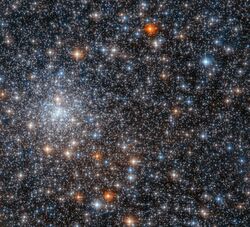Astronomy:NGC 6558
From HandWiki
Short description: Globular cluster in the constellation of Sagittarius
| NGC 6558 | |
|---|---|
 The globular cluster NGC 6558 imaged by the Hubble Space Telescope | |
| Observation data (J2000 epoch) | |
| Class | V |
| Constellation | Sagittarius |
| Right ascension | 18h 10m 18.38s[1] |
| Declination | −31° 45′ 48.6″[1] |
| Distance | 24.1 kly (7.4 kpc)[1] |
| Apparent magnitude (V) | 11.29[1] |
| Physical characteristics | |
| Radius | 5.2' x 5.2'[2] |
| Metallicity | [math]\displaystyle{ \begin{smallmatrix}\left[\ce{Fe}/\ce{H}\right]\end{smallmatrix} }[/math] = -1.32[3] dex |
| Other designations | Cr 368, GCl 89, ESO 456-62, VDBH 259[1] |
NGC 6558 is a globular cluster, located about 24,000 light years away in the constellation Sagittarius. Its apparent magnitude is about 11 and its apparent diameter is about 10 arcminutes.[2] The globular cluster was discovered in 1784 by the astronomer William Herschel with his 18.7-inch telescope and the discovery was later catalogued in the New General Catalogue.
It is located 1.5 degrees south-southeast of Gamma2 Sagittarii.
References
- ↑ 1.0 1.1 1.2 1.3 1.4 "NGC 6558". SIMBAD. Centre de données astronomiques de Strasbourg. http://simbad.u-strasbg.fr/simbad/sim-basic?Ident=NGC+6558.
- ↑ 2.0 2.1 "NGC 6558". http://spider.seds.org/spider/MWGC/n6558.html.
- ↑ "A Galactic Globular Clusters Database: NGC 6558". http://gclusters.altervista.org/cluster_4.php?ggc=NGC+6558.
External links
 |

